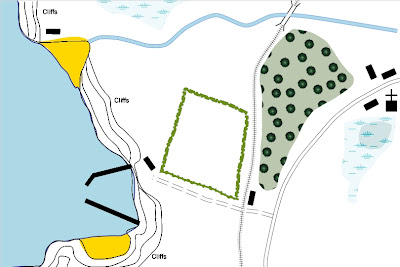The Rebel attack started with a general advance all along his line (no call for subtlety here). However, I hadn’t quite clocked how strong the attack on my left would be with a total of six Rebel regiments against two Union regiments backed up only by the battery in Redoubt C (see previous post for battle map and set-up).
Splitting what little infantry I had on the left I sent a regiment of Zouaves into the woods at the far left to counter Rebel infiltration on my flank, whilst one Union regiment was moved forward to close the gap between Village A and Redoubt C.
My thinking was that maybe I could keep the Rebels at arm’s length while my batteries in the redoubts could cut them up and perhaps weaken them enough so that I could hold on to two of the three objectives by the end of the game, as required by the scenario. Meanwhile, in the centre the Rebels advanced steadily (perhaps suicidally) towards Redoubt 1.
However, back in the gap between Village A and Redoubt C, things didn’t turn out too well, as you can see from the before and after photos below. Somehow, I think that the ‘effectiveness’ of these free Cold Harbour rules could be tweaked a bit!
Before: (What? Outnumbered four to one? Piffle!).
After: (Bang! Heh-heh ... er... how come we missed one?)
Having swept the opposition away in just a few short volleys and with unerring accuracy (with the dice at any rate), the Rebels rushed forward to clear the gap, sending a further regiment confidently on to assault Redoubt C, as shown in the photo below (way in the distance, beside the wood).
In the foreground the Rebels were already occupying Village A, trampling though gardens and vegetable patches in front of Redoubt 1. Wasn’t I supposed to hold on to that objective? Here is a view of Redoubt 1 (Spencer Smith general in the background).
Back on the left, the unit attacking Redoubt C did take some casualties, before the Union battery started to waver (note Union Zouaves reforming in the background as more Rebels advance through the woods).
Meanwhile the Rebel advance through Village A towards Redoubt 1 was not faring so well and these units suffered, although not before picking off my artillerymen, with some help from their supporting artillery (see below, view from Union left flank).
Unfortunately with the Confederates poised to overrun Redoubt C and already in possession of Village A, as well as Redoubt 1 cleared of Union artillery, we ran out of time. Another few moves, though, and I think that the Rebels would have quickly got behind Village A and started to roll up the remaining Union forces and would have won the game decisively.
Overall, an interesting scenario and one to try again another day, but not much of a thumbs up for the Cold Harbour rules, which were a little too bloody for the brigade size games we normally play. I’m all for decisive results but am not so keen on losing 95% of a regiment in the space of two moves after a few good die throws!
Nevertheless, it was good to get the old troops out (and the terrain), and hopefully they’ll get an airing again sometime soon.
Regarding other ACW rules I’ve been keen on Circa 1863 (Tabletop Games), with some slight modifications, for a very long time, having won many grinding, bloody, ebb/flow, and intensely satisfying battles in the past with them. They do take some time to play though but we usually seemed to have more time in the old days. However, I am now looking seriously at Regimental Fire & Fury, which I’m hoping to try out for our next outing.

















